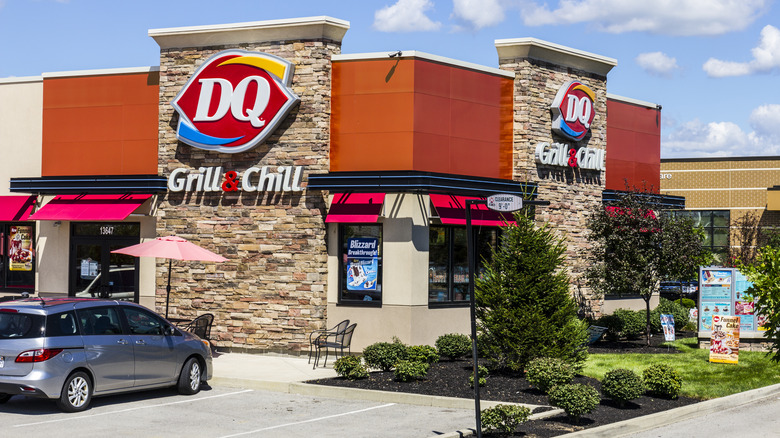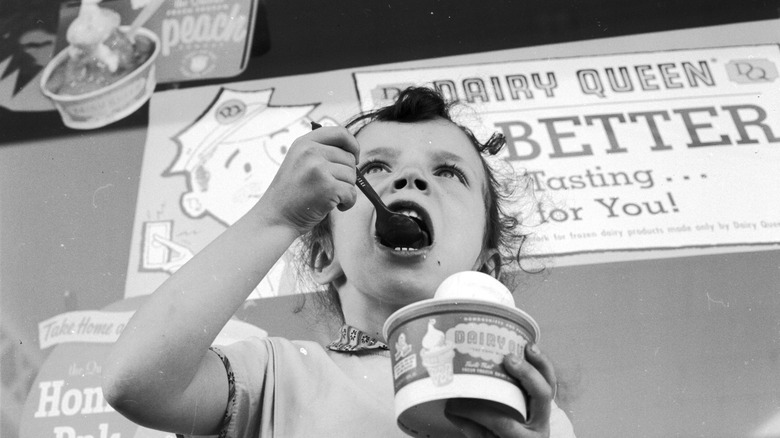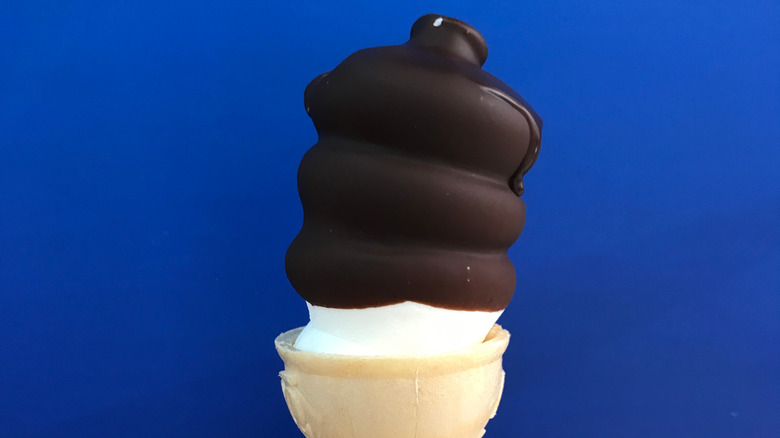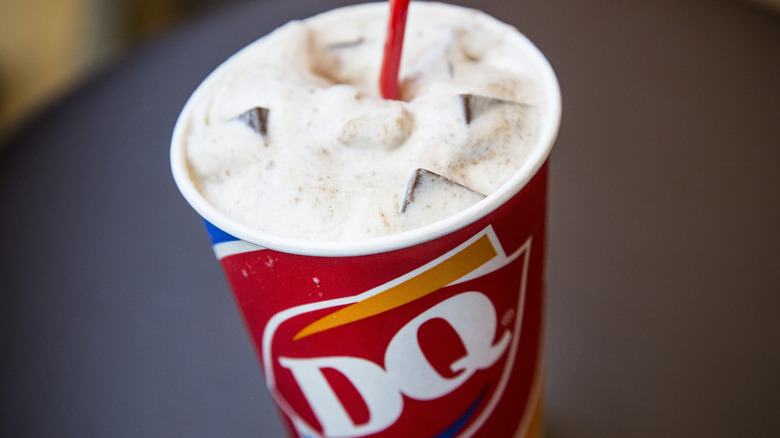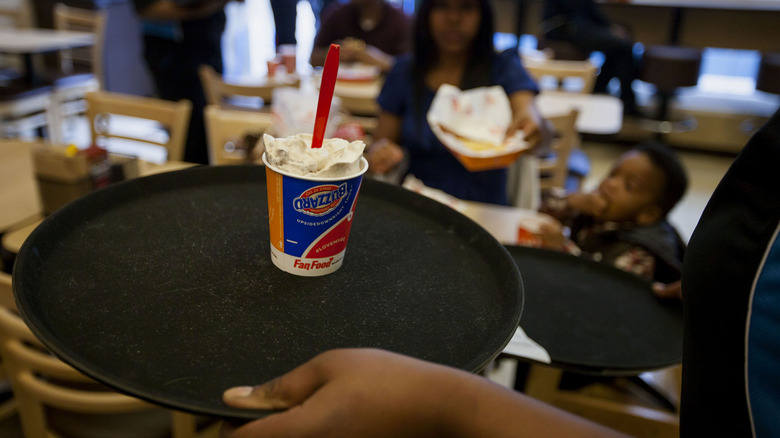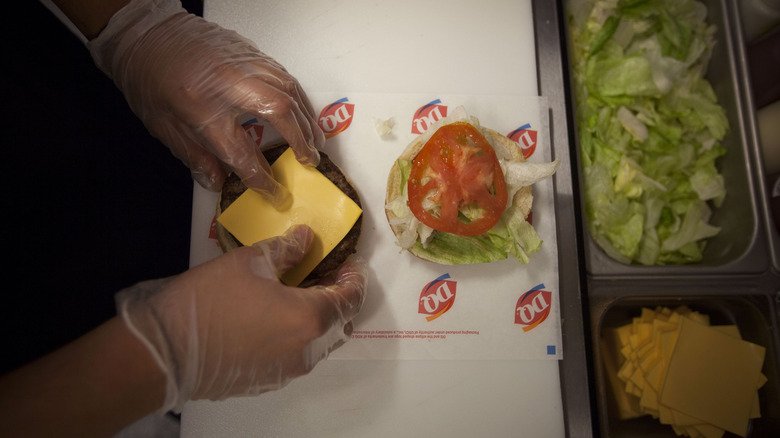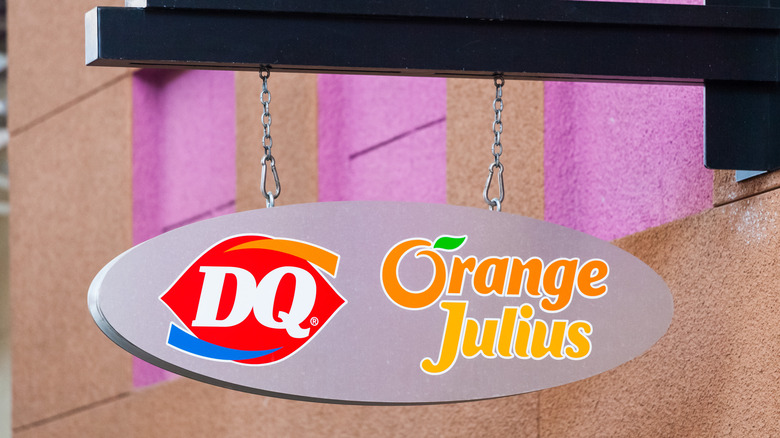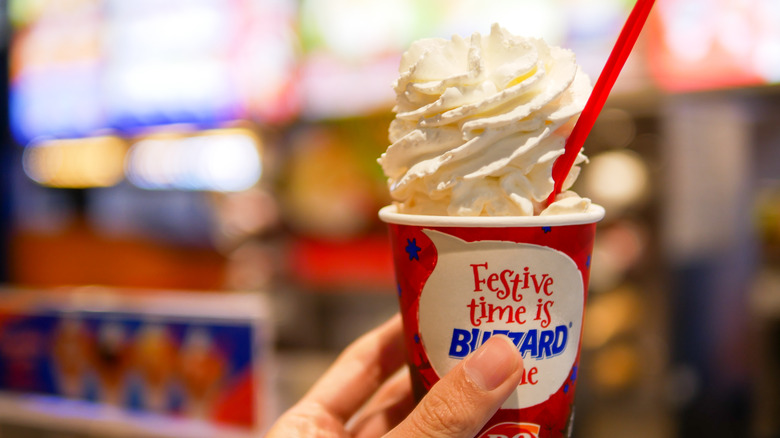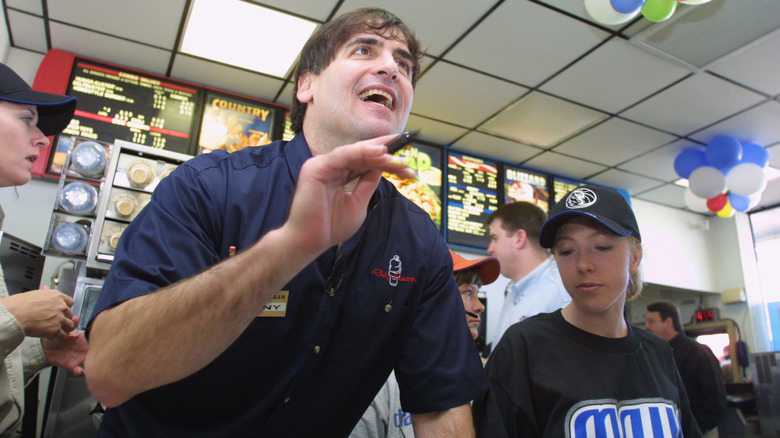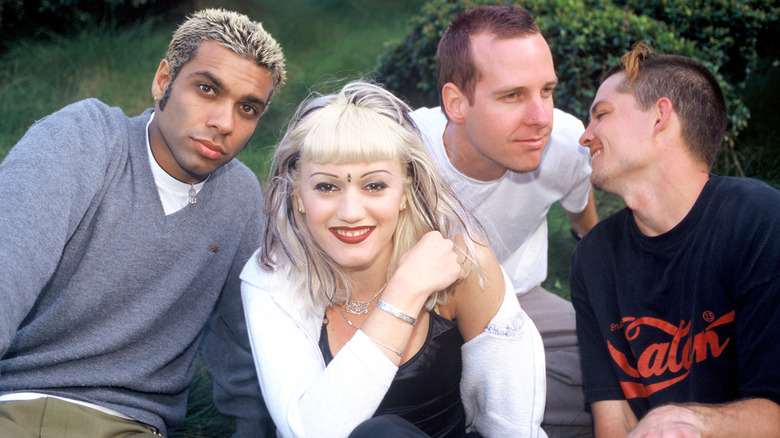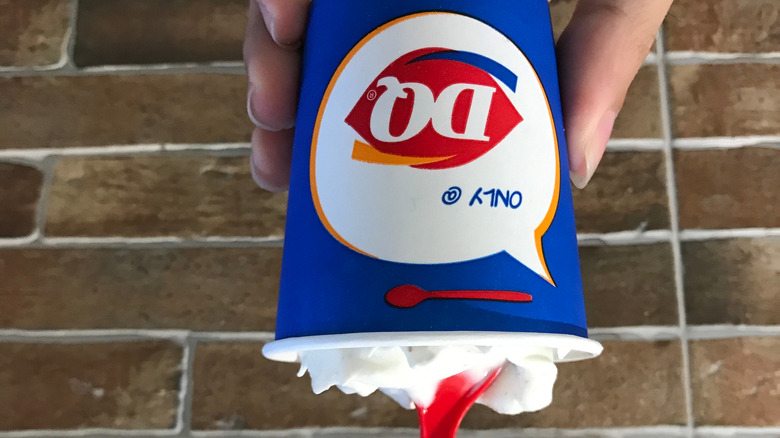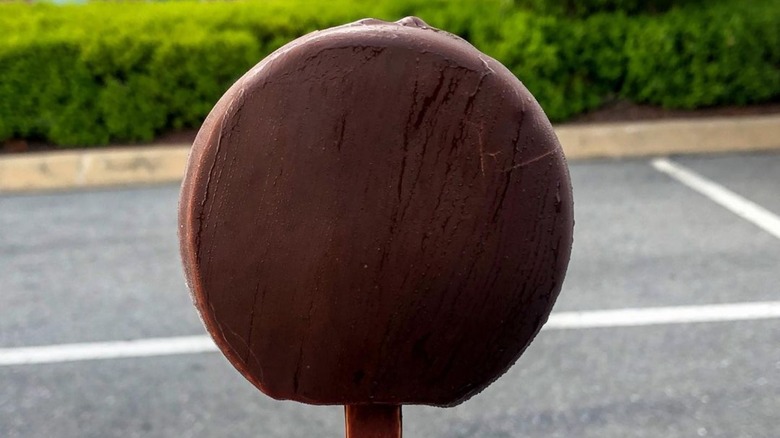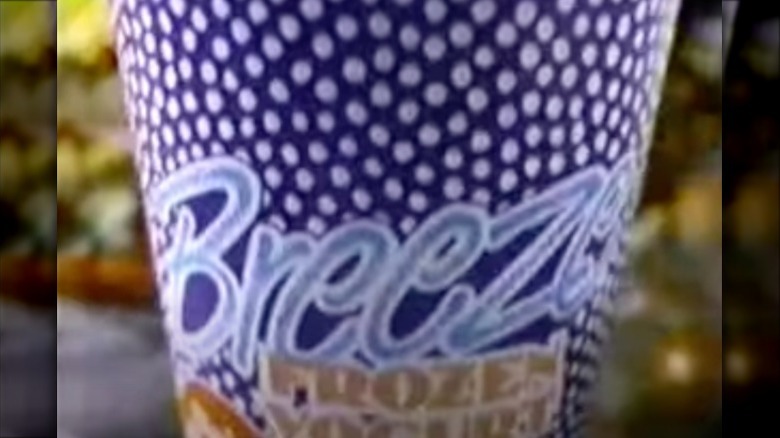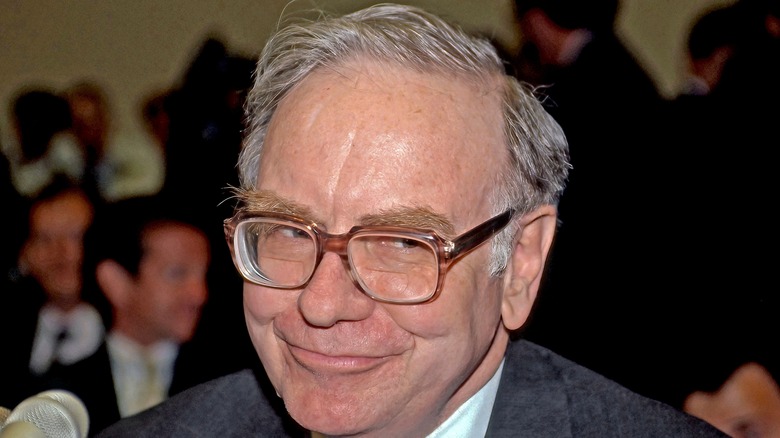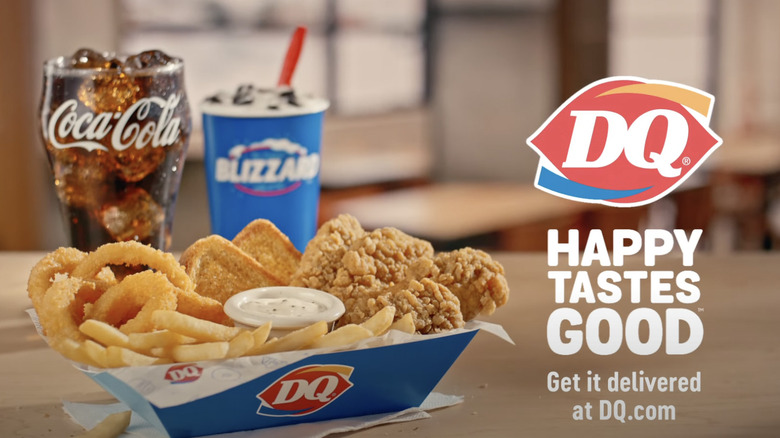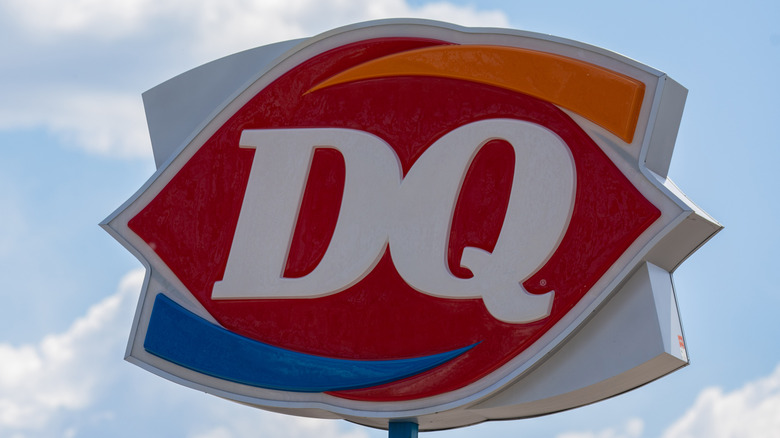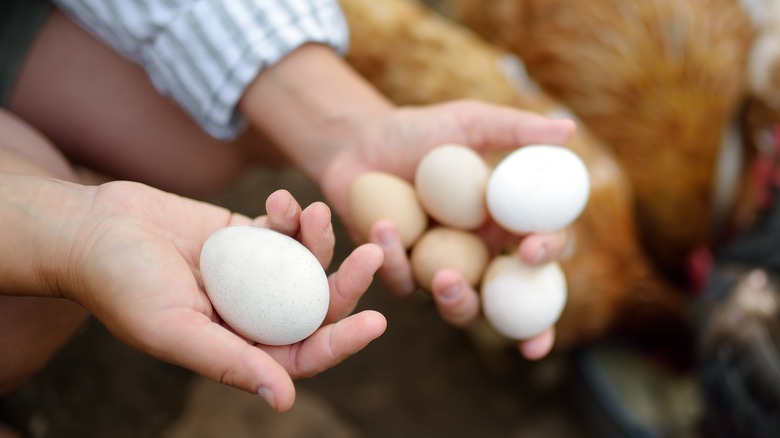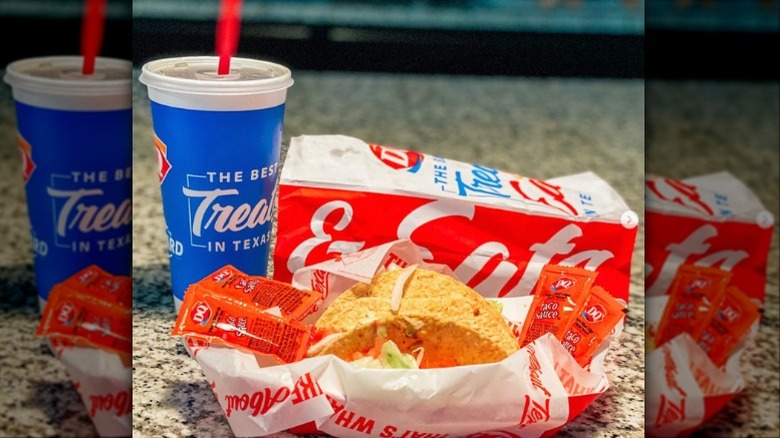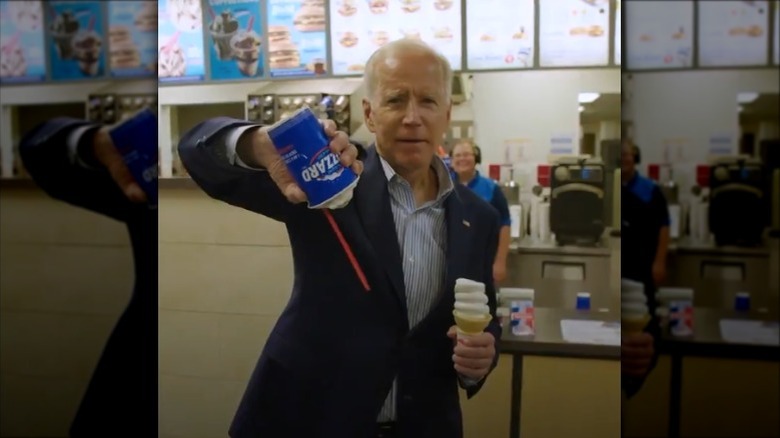Dairy Queen: 18 Facts About The Classic Fast Food Chain
If you've ever been on a road trip across the United States or even just gone for a drive around your neighborhood, you've likely seen a Dairy Queen or two. The fast food joint is known for its delicious frozen treats and classic food items like burgers, french fries, chicken strips, and more. It's also beloved by people all over who run to the chain to satisfy their sweet tooth.
But there's more to Dairy Queen than meets the eye, and that's kind of an understatement. Sure, Dairy Queen might just seem like your typical fast food restaurant, but there's a lot that makes the fan-favorite different from your typical burger joint. From their menu to their policies, and even some controversy they've faced, Dairy Queen isn't like other restaurants. More, the untold truth of Dairy Queen is super interesting, and it proves just how far the chain has come since it first opened up.
Dairy Queen has been around for a while, and it started in this state
While these days most Dairy Queens feature a modern exterior and an updated menu, the franchise obviously has a long history that extends far beyond what you probably assumed. Sure, Dairy Queen has changed over the years, but to look back at when it first got started is still pretty fascinating. The company's history also explains why so many people think of Dairy Queen as a totally classic fast food place.
Tthe first Dairy Queen ever opened in 1940 in Joliet, Illinois. Clearly, Dairy Queen has been around for a while, and since it actually started in a small city in Illinois, it has all-American credentials. Being born in middle America makes Dairy Queen exactly the kind of place that people crave while on a road trip Stateside or when wanting some kind of comfort food.
This was the original DQ menu
As is the case with most fast food joints, Dairy Queen has seen quite a few changes over the years that it's been operating. Obviously, considering the fact that the chain has been around for so long, it makes sense that things like the menu would be different now than back in the day. And that's the truth.
Back when Dairy Queen first opened, the menu was a lot smaller and simpler than it would eventually become. In fact, milkshakes and malts weren't put on the menu until 1949, nine whole years after Dairy Queen first opened its doors. The original Dairy Queen menu looked a lot different than it does today. Sure, they originally served soft-serve cones, ice cream sundaes, and larger containers of ice cream, but the costs of their most popular items is what is truly staggering. Specifically, a soft-serve cone only cost five cents — just a nickel, and a fresh hot fudge sundae was just eight cents. While the delicious additions to the Dairy Queen menu are certainly welcome, those prices would be nice.
The famous DQ blizzard wasn't always on the menu
While the Blizzard might be Dairy Queen's most well-known product, it actually wasn't on the menu for quite some time since it opened. In fact, it took about 45 years for the Blizzard to get on the menu. Specifically, the Blizzard hit stores in 1985, and restaurantgoers were instantly taken with the soft-serve ice cream treat blended with chopped-up candy bars or even cookies.
The Blizzard was so monumental that The New York Times covered it about a year after it launched. ”It's certainly the biggest thing that has happened to Dairy Queen in the last 25 years,” Harris Cooper, International Dairy Queen's president and chief executive, told the publication.
Americans were absolutely smitten with the Blizzard, with restaurant workers telling The Times that the machines were usually constantly running to meet the demands of their customers. Blizzards might be your go-to menu item when you head to a Dairy Queen these days, but it was years before the famous treat hit the menu.
But Blizzards aren't even ice cream
When you think of the treats at Dairy Queen, you likely think of them as ice cream. After all, it's frozen, creamy, and isn't soft serve typically in the "ice cream" category anyway? Well, not always. As it turns out, the United States Food and Drug Administration (FDA) has specific requirements for something to be called "ice cream" — and Dairy Queen's soft serve and Blizzard treats don't meet those requirements.
In fact, the Dairy Queen website actually states as much: "Technically, our soft serve does not qualify to be called ice cream. To be categorized as ice cream, the minimum butterfat content must be ten percent, and our soft serve has only five percent butterfat content."
So, while you can call a Blizzard a delicious frozen treat, there's a reason they won't call it ice cream — because it's made from their soft serve, which isn't technically ice cream. That said, it's still pretty delicious.
Dairy Queen has faced rumors about its quality of meat
In addition to delicious frozen treats and snacks, Dairy Queen is also pretty well-known and popular for its food items. Ranging from burgers to chicken to salads, and onion rings and soft pretzels, Dairy Queen has plenty to choose from if you're craving more than just a Dilly bar. But as far as those hamburgers are concerned, there's been some concerns.
Someone had complained that there was "human meat" in the burgers that Dairy Queen was serving. But Dairy Queen maintains that couldn't be further from the truth. Those rumors got started because of an FBI raid at a Greenwood, South Carolina Dairy Queen. But manager Saif Momin denied that. "If that was the case, they already would have shut me down," Momin said (via New York Post). "I just want to make sure people know it has nothing to do with my business. They were looking for people that don't work there." And the FBI was looking for someone participating in an unlicensed money-transfer business at that location. So no, when you order a Dairy Queen burger, there's no chance you're eating human meat.
Dairy Queen took over Orange Julius
If you've ever been to a Dairy Queen, you might have noticed that they sometimes have a special section of their menu that isn't just soft serve or burgers or even ice cream cake. No, there's an entire section on most Dairy Queen menus reserved entirely for a brand of beverage that you might not have even heard of. The Orange Julius isn't as popular today as it was years ago, but you can still savor the sweet drink at most Dairy Queen locations as it turns out.
A traditional Orange Julius consists of orange juice, ice, sugar, egg whites, milk, and vanilla. The drink was very popular in the 1950s through the 1980s and really took off when Dairy Queen bought the brand in 1988. In fact, many Dairy Queen locations also became Orange Julius locations after the buyout, and the two merged into one.
In addition to the traditional Orange Julius, Dairy Queen also offers smoothies and a strawberry banana orange Julius drink as well, all under the Orange Julius umbrella. So, if you're ever craving a creamy, orange treat, you know where to go.
This is how important the DQ soft serve recipe is
While you might not care to know just how Dairy Queen makes its burgers or fries, anyone who has had the chain's soft serve is probably interested in how they could replicate the concoction at home. But when it comes to Dairy Queen's famous soft serve recipe, that's kept top secret. In fact, the recipe is so important to Dairy Queen that executives wouldn't even discuss it during an interview.
Dairy Queen's chief branding officer, Michael Keller, told ABC News it was impossible for anyone else to know the recipe for what makes that soft, creamy, ice-cold treat so delicious. "There's no way I could tell you what's in that formula .... it is kept in a safe deposit box and there are only a few keys to it," Keller said.
Because the soft serve is so iconic and is used in Dairy Queen's other fan-favorite treat, the Blizzard, it makes sense the company would want to keep the recipe under strict lock and key. If you weren't aware of just how seriously Dairy Queen takes its soft serve, you are now.
Mark Cuban had a Dairy Queen controversy
You might be surprised to learn that someone like business mogul and Shark Tank star Mark Cuban has actually worked at a Dairy Queen before, and not just as a teenager or young adult trying to earn some extra cash.
Cuban, who owns the Dallas Mavericks basketball team, landed himself in some hot water when he made a disparaging comment about Ed Rush, the director of NBA officials. "Ed Rush might have been a great ref, but I wouldn't hire him to manage a Dairy Queen," Cuban said (via Dallas Morning News). The NBA then fined Cuban $500,000 for "repeated public criticism of NBA officiating," but that wasn't where the story ended. In fact, Cuban flew to a Dallas area Dairy Queen to work there for a day.
Apparently, Cuban was a natural behind the counter as he took orders, served up treats, and even made some Blizzards for customers: "He caught right on," Cuban's fellow Dairy Queen employee, Sharon West, told Dallas Morning News. "He is a fast learner." Clearly, Cuban learned his lesson and worked hard at Dairy Queen, lest you think the billionaire is above serving burgers and fries.
The band No Doubt formed at Dairy Queen
When you think of Dairy Queen you might not think of a pop-punk band from the 1990s, but as it turns out, the band No Doubt formed at a Dairy Queen.
Former No Doubt band member John Spence actually helped launch the band in a pretty fascinating location. While Spence, Gwen Stefani, and her brother, Eric, were whipping up chocolate-dipped cones in 1986, they decided to get serious about music and start a band.
Stefani even revealed Dairy Queen was a pretty important job for her for another reason. In an interview with Marie Claire, she revealed she made her first dollar while working at the chain. With that, Stefani proved once and for all that celebrities really are just like us. Of course, not everyone forms a world-famous band at their first real job, but you get the point.
This is why Dairy Queen serves their blizzards upside down
If you've ever ordered a Blizzard from a Dairy Queen, odds are you've had it handed to you upside-down. And there's a reason for that. Dairy Queen itself claims that the Blizzard is different than your typical frozen dessert, saying, "We do things differently here. We defy gravity." In order to prove to customers that their Blizzards really do defy gravity, and are so thick and creamy, most Dairy Queen workers will serve you your Blizzard upside down, or it's free. The key word there being most.
But not every Dairy Queen will give you your Blizzard for free if it's not served upside down. "The independent franchise owner of each restaurant decides whether the Blizzard Treats in their location will be served upside-down and if they participate in the 'Upside Down or the Next One's Free' promotion," the DQ website states. So, before you get too excited about this possibility and order a Blizzard while expecting a fancy upside-down trick, make sure that location participates in the promotion. Otherwise, you'll just be disappointed.
Dilly Bars debuted at DQ in the 1950s
Bob and Phyllis Litherland ran the Dairy Queen in Moorhead, Minnesota from 1949 until the mid-1990s. Per Litherland family lore, an ice cream mix supplier stopped by the store one day in 1955 and dispensed some soft-serve onto thick paper, stuck a wooden stick into it, and then dipped it in chocolate. As for the name? "Somebody said, that's really a dilly," Phyllis Litherland told StoryCorps in 2010 (via The Dickinson Press). The Litherlands put the Dilly Bar on the menu for 10 cents and it was soon a hit.
Dairy Queen eventually adopted the Dilly Bar for all of its restaurants, which now use a supplier that ships them ready-made. But the one in Moorhead still makes its Dilly Bars fresh and by hand. Yet Dairy Queen's corporate office won't acknowledge or promote the Moorhead outlet as the official birthplace of the Dilly Bar, in part because the handmade ones differ so greatly from the standardized treats. "It falls outside the dining experience DQ fans across the country are looking for," a spokesperson told Bring Me the News. Be that as it may, in 2018, the Moorhead Dairy Queen became the home of a 12-foot-tall Dilly Bar statue to commemorate its status as the birthplace of the famous ice cream treat.
Breeze frozen yogurt was cut from the menu
What's probably the most all-time famous Dairy Queen treat wasn't on the restaurant chain's original menu. The Blizzard made its debut in 1985, more than four decades after Dairy Queen launched in Joliet, Illinois. It's made by mixing candy pieces, baked goods, or fruity sauces with the chain's vanilla soft-serve. All that makes for a densely caloric and fat-loaded treat, and so the Blizzard was eschewed by the many health-conscious Americans who made low-fat, reduced-calorie frozen yogurt such a massive food fad in the 1980s. Looking to catch a trend and grab departed customers and fro-yo-loving new ones, Dairy Queen introduced the Breeze in 1990. This was a Blizzard made with frozen yogurt, which contained 30% fewer calories than DQ's soft serve.
Though the Breeze never reached the sales or cultural heights of the Blizzard, Dairy Queen steadfastly stuck with the Breeze. Yet, problems persisted. Some store operators complained that the mix they had to buy to make the Breeze would expire before they could use it all. Finally, by 2001, Dairy Queen had permanently discontinued the Breeze.
Warren Buffett spent hundreds of millions to acquire Dairy Queen
Warren Buffett is famously one of the richest people on Earth. Through his holding company, Berkshire Hathaway, he's made billions through the acquisition and operation of well-known consumer brands. Moreover, Buffett has a habit of buying companies that make products he and millions of others enjoy, such as See's Candy, Benjamin Moore paint, and Fruit of the Loom underwear. In 1997, after acquiring plenty of stock in Coca-Cola and McDonald's, he executed another food-based purchase with a high-profile takeover of Dairy Queen.
That year, Berkshire Hathaway bought all of Dairy Queen for the whopping sum of $585 million. Doing so was a longstanding life goal for Buffett. "Warren tells the story that when he was young he took a young lady to Dairy Queen, she had a great experience, and he said if he ever had the opportunity he would buy the business," Dairy Queen CEO John Gainor told Fox Business News in 2016. "So he did."
The actual sale took about a year to complete. After major Dairy Queen shareholder and board member Rudy Luther died in early 1997, the executors of his estate offered Buffett the chance to buy Luther's shares to get the money to pay off a tax bill. Buffett turned them down but sent word to Dairy Queen that he'd be willing to buy the entire operation if given the chance.
There have been a number of DQ slogans over the years
Dairy Queen has tried on quite a few different slogans over its long history, usually letting them sink into the public consciousness before moving on to a new one after a few years. In 1980, Dairy Queen introduced its best-known and longest-lasting campaign with the wordplay-based "We treat you right" promising customer service as well as special desserts.
Around the turn of the new millennium, DQ tried out something different with the 2000s-era slogan "DQ Something Different." That was phased out around 2011 in favor of the youth-courting, slang-oriented "So good it's RiDQulous," followed by a nod to the rise of fandoms with the 2013 introduction of "Fan food, not fast food." As of 2019, Dairy Queen's primary marketing tagline is the simple "Happy Tastes Good."
In addition to all those turns of phrase, Dairy Queen more specifically promotes its meal items and variety with dedicated slogans, too. In 1992, the company filed a trademark on the slogan "Hot Eats Cool Treats." The company wanted to let the world know that many of its stores sold more than just ice cream and were outfitted with a grill. Those locations, branded as "Brazier" outlets, were prepped to sell hamburgers and hot dogs.
What the Dairy Queen logo means
Dairy Queen started small and simple as a single location in Joliet, Illinois in 1940. The shop lured in customers with a straightforward outdoor sign spelling out the business name in big block letters. As the company rapidly expanded in the 1950s, so too would its signs and logos evolve. Dairy Queen's signs and packaging in the mid-20th century utilized a blue and white scheme, with the name of the business spelled out in thick letters in those colors.
In 1960, Dairy Queen adopted the first iteration of its now-famous red and white logo. At the time, it consisted of a red dollop with "Dairy Queen" printed on it in crisp upper- and lower-case letters. That stayed the logo on all signs and marketing materials for more than 40 years, altered slightly in the 2000s with a change from the full "Dairy Queen" into the hipper, shorter DQ. In 2007, the company unveiled the logo currently in use. An update and reworking of the red used since the '60s, it still featured that color and a slanted "DQ," flanked with swooshes of blue and orange. Given that DQ has been referred to as the home of "hot eats, cool treats," the orange represents hot foods like hamburgers and hot dogs. The blue is for cold stuff such as ice cream.
Dairy Queen is working on being a cage-free egg consumer
Simply put, Dairy Queen uses a lot of eggs. Its signature Blizzard is made with eggs, which can also be found in a number of other desserts and hot food items. In 2016, Dairy Queen responded to pressure from animal rights groups and joined other large food distributors like Walmart and Costco by promising to change its sourcing methods. The plan: purchase only eggs that have been produced by farms that keep chickens on a free-range, non-caged basis.
In 2021, parent company International Dairy Queen gave an update on its move toward 100% cage-free egg compliance. "As we continue to make progress toward our goal, we reduced the number of proprietary ingredients not yet using cage-free eggs by more than 35 percent," Dairy Queen executive Steven Min told QSR. One major achievement to that end: All Blizzards company-wide now are made from cage-free egg-based ingredients. Dairy Queen is on track to be completely cage-free by 2025.
Texas can't get enough Dairy Queen
As of 2023, there are about 4,300 Dairy Queen outlets in the United States. The state with the biggest DQ presence by far is Texas, home to 589 locations. That reflects the size and large population of Texas as well as the phenomenal and enduring popularity of Dairy Queen there. In 1947, less than a decade after opening its first store in Illinois and dabbling in expansion, International Dairy Queen sold the rights to open stores in Texas to franchisee O.W. Klose and his son, Rolly Klose. The Kloses then subcontracted to other operators and let them experiment with their own menus. Their contracts with DQ HQ were so vague that they could legally get away with selling almost anything they wanted beyond soft-serve ice cream.
By the time International Dairy Queen reacquired Texas Dairy Queen in 1980, stores statewide had deeply entrenched themselves in the state, gaining a loyal following and offering menu items not found anywhere else in the DQ system. Today, Dairy Queen Texas acts as an independent division inside of the global operation, selling both company-mandated favorites like the Peanut Buster Parfait, Dilly Bar, and Blizzard, as well as a number of Texas-only items, like chicken-fried steak as part of The Dude Chicken Fried Steak Sandwich and in the Steak Finger Country Basket. Texas Dairy Queens also serve Texas T-Brand Tacos and Hungr-Buster burgers.
DQ is a hotspot for campaigning politicians
Small-town American life is heavily romanticized in both popular cultures and by politicians. It's almost inevitable that, in each election cycle, a candidate for a national office will be seen stumping for votes and shaking hands with regular people in diners and Dairy Queens, both of which are in abundance in small towns. A campaign-friendly stop at a Dairy Queen to mingle with middle-class people and eat middle-class food has factored into the strategy of candidates who won and lost their respective elections.
In October 2020, then-presidential candidate Joe Biden made one of his final stops before his successful election at a Dairy Queen on National Dessert Day, posing for a Twitter video while holding a soft-serve cone with one hand and performing the signature upside-down Blizzard flip with the other. Back in 2015, in advance of the Iowa presidential election caucuses, Jeb Bush held his first candidate interview at a Dairy Queen in the state. Yet he didn't eat any ice cream, instead sipping on an Orange Julius while talking about his low-carb diet. Bush dropped out of the race not long after finishing a distant fifth in the Iowa caucuses.
